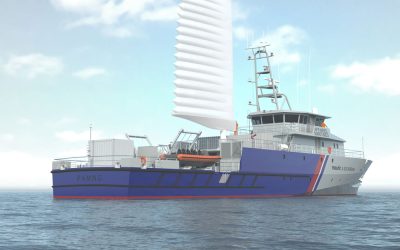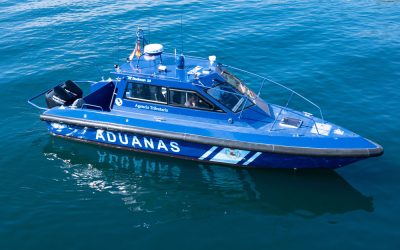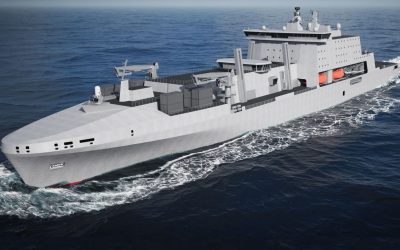Classification society and shipbuilder enter strategic framework to advance the digital transformation of shipbuilding
In the ever-changing currents of shipbuilding technology a newly announced collaboration between the American Bureau of Shipping (ABS) and South Korean shipbuilding company Hanwha Ocean could be a transformative force in naval architecture.
Announced in January 2023, the deal signed by the two organisations is the latest in a series of joint projects under the umbrella of ABS’ Smart Yard initiative. The two companies hope the new collaboration will set new benchmarks for progress and steer the industry towards a digitally empowered future.
ABS, a global authority in classification services, prides itself on a rich history of active involvement in joint development projects. Insights from Patrick Ryan, senior vice president and chief technology officer at ABS reveal that the organisation consistently undertakes an impressive average of around 75 such projects annually across diverse domains. However, the collaboration with Hanwha goes beyond a one-off project; it represents a strategic alliance that surpasses conventional joint development initiatives.
Ryan highlights the significance of the Smart Yard agreement. “It allows ABS and Hanwha to collaborate in various ideation processes, creating a robust framework for different ideas and innovations to move forward in using technology to fulfil our mission,” he states. This emphasises the strategic depth of the collaboration, underscoring the shared commitment to pushing the boundaries of maritime technology.
In February 2023 ABS launched the Guide for Smart Technologies for Shipyards, a detailed series of conditions to guide the industry in the application of smart technologies at shipyards. The guide, a first of its kind, offers insight into how shipyards can incorporate new digital technologies in their operational processes. This joint development project, with a primary focus on shipbuilding and Smart Yard technology, seeks to redefine existing norms and envisions a future where the maritime sector is fully digitalised by the year 2050.
The Smart Yard project focuses on utilising digital technologies to augment safety and efficiency during ship construction and surveying. According to ABS, these new technologies utilise digital and data-driven innovation in three key areas. The first is the concept of hyperconnectivity which will allow real-time data access and information sharing between shipyards, clients and classification societies. Secondly, advanced automation will help aid production by allowing more tasks to be performed using automation in order to replace human responsibilities. Lastly, data-driven intelligence generated through analysis by engineering algorithms or human level computer intelligence will assist the overall design process.
Hanwha is the latest company to collaborate on the Smart Yard project, following the successful collaboration between ABS and companies such as Seatrium. The collaboration between ABS and Hanwha encompasses a broad spectrum, touching upon simulations, digital twins, wearable devices, and cyber controls.
The South Korean company is a notable player in the shipbuilding industry and brings a wealth of experience and innovation to the table. Formerly known as DSME (Daewoo Shipbuilding & Marine Engineering), the company has a storied history that extends over decades. ABS and Hanwha have cultivated a longstanding relationship, with numerous joint projects spanning years. This history of collaboration forms the bedrock of their current joint endeavours, contributing to the seamless synergy evident in their Smart Yard collaboration.
ABS emphasises that the significance of this partnership goes beyond technological innovation. The critical role of collaborative projects such as that between Hanwha and itself helps to advance the digitalisation of the maritime industry and plays a pivotal role in achieving safety and environmental goals.
The collaboration with Hanwha therefore extends beyond technology and safety and plays a part in the broader context of the industry’s digitalisation. Hanwha brings a unique perspective and expertise to the collaboration, according to Ryan.
“Hanwha is an important client for us. They’re very forward-looking, certainly in autonomy, smart technology, cyber, and related technological paths connected to the smart yard agreement,” he acknowledges, a sentiment which highlights the qualities of the partnership and the depth of understanding between the two companies.
From the focused emphasis on Smart Yard technology in the strategic application of artificial intelligence, virtual assets, and autonomous functions, the project also encompasses a broad spectrum of activities.
The ultimate goal, as articulated by Ryan, is to be able to support a fully digitalised shipbuilding industry.
It is just one of a series of initiatives designed to enable development of transformational technologies in the marine and offshore industries. The company has developed a conceptual guide for this purpose, known as the “Technology Trends” wheel. This serves as a dynamic tool, providing strategic guidance to ABS and its collaborators, aligning their projects with the overarching vision of digitalisation across the maritime sector.
Using the wheel as a guide, Ryan hopes that companies will be able to understand how technologies can be combined to push the boundaries of technological innovation in the maritime industry. “I could build a virtual model of a carbon capture system that uses AI to make decisions on when the system should be performing in different carbon capture technologies,” he says, as an example of how the technologies can intersect.
ABS hopes that the Hanwha collaboration will be a blueprint for the future of maritime innovation. The strategic alliance between the two companies underscores the resilience and determination of both to embrace the opportunities presented by cutting-edge technologies.




